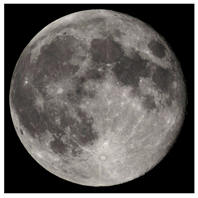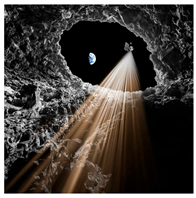Abstract
Amid long-term human consumption of surface resources and the intensifying climate crisis, underground space has increasingly attracted attention as a viable alternative for habitation, survival, and urban resilience. Historical and contemporary examples—from the Derinkuyu Underground City in Cappadocia, Turkey, to Iran’s “Shavadan” cooling system, as well as subterranean dwellings in hot arid regions such as the Berbers’ homes in Tunisia and miners’ settlements in Coober Pedy, Australia, and underground complexes in cold regions like Harbin, Sapporo, and Helsinki—demonstrate the significant advantages of underground spaces in thermal regulation, protection from extreme weather, and efficient resource utilization. With climate change driving increasingly frequent and severe extreme weather events, including tornadoes, typhoons, and prolonged droughts, surface buildings face growing vulnerability, further emphasizing the potential of underground space for sustainable urban development. In parallel, advances in science and technology, particularly in space exploration, have accumulated extensive practical knowledge, creating pathways to extend terrestrial construction experience into extraterrestrial environments. The Moon, despite its strategic significance and potential resource value, presents an extremely hostile surface environment characterized by microgravity, near-vacuum conditions, extreme diurnal temperature variations of several hundred degrees, and very low thermal conductivity, all of which render conventional surface habitation challenging and prohibitively costly. Consequently, contemporary research has gradually shifted focus from lunar surface facilities toward the development and utilization of lunar underground spaces, which could provide enhanced environmental stability and habitation potential. This paper reviews the historical development and current research on lunar underground space utilization, proposes five guiding principles for its progressive exploration and construction, and presents a phased “1.0–4.0 era” framework for systematic development. Additionally, based on an adaptive design theoretical framework, spatial, environmental, and climatic strategies are proposed to guide future lunar habitation and ensure sustainable extraterrestrial development, providing a comprehensive reference for long-term planning and construction of lunar underground habitats.
1. Introduction
With the continuous growth of the Earth’s population and the increasing consumption of non-renewable resources, the planet’s resources are becoming increasingly depleted, and environmental problems are becoming more severe. In the search for new resources and living space, humanity’s exploration of outer space has deepened. Owing to its unique geographical location and resource advantages, the Moon has become one of the primary targets for future space development. Against this backdrop, extraterrestrial construction in the lunar environment has emerged as a focal point in international scientific and technological competition. The roadmap for deep space exploration by the National Aeronautics and Space Administration (NASA) indicated that research on lunar outposts began in 2018 []; the Russian government’s “2006–2040 Long-Term Space Development Plan” envisioned the establishment of a manned lunar base between 2028 and 2032 []; the European Space Agency (ESA), through its “SMART” program, has been making scientific and technological preparations for building a lunar base; and the Japan Aerospace Exploration Agency (JAXA) announced in its draft “Long-Term Space Development Vision” plans to cooperate internationally in building a lunar solar power research base before 2025 [,]. Based on these initiatives, major spacefaring nations have proposed various conceptual schemes, including the Lunar Habitat [], Lunar Base [], Moon Village [], Lunar Research Station [], and lunar space stations []. 1961, NASA and Goodyear proposed a toroidal inflatable base concept. In 1963, NASA collaborated with Boeing to develop the early modular concept of the Lunar Exploration System for Apollo (LESA), and an updated version of the LESA module was presented in 1969. In 1988, the Human Systems Division at NASA’s Johnson Space Center introduced a spherical inflatable lunar habitat concept, characterized by a deployable, air-supported shelter structure designed for lunar surface operations []. In 1992, Nowak et al. proposed a modular inflatable structural system, in which unitized modules could be assembled into lunar bases of various scales []. In 2007, Arturo Vittori and colleagues at Architecture and Vision proposed “MoonBase Two”, an inflatable laboratory located near Shackleton Crater at the lunar south pole, designed for long-term scientific habitation []. In 2017, Monika Lipińska and her team presented the “Test Lab” proposal in Moontopia—the first international space habitation design competition organized by the South England-based magazine Eleven. The design was conceived as an almost living organism capable of hosting human life, exploring biomimetic strategies for lunar habitats. In 2019, Cheng Zhou et al. proposed the “Xuanwu Station” lunar habitation concept, which integrated elements of Chinese traditional culture into the spatial design [] (Figure 1).

Figure 1.
Representative Concepts of Lunar Surface Facilities (drawn by the author).
China’s lunar exploration program has achieved remarkable success. Following the completion of the first three phases, plans for the fourth phase have been set as a pioneering mission, aiming to cooperate with multiple countries to build an International Lunar Research Station capable of long-term autonomous operation with short-term human participation. After 2040, it is planned to upgrade this station into a practical, multifunctional lunar base [,,]. Building on this, Guo Linli and colleagues proposed an integrated manned lunar base concept [,]. The team led by Mei Hongyuan proposed architectural concepts for China’s future lunar bases based on different construction environments on the Moon—“Clover” (for lunar surface environments) and “China Star” (for lunar pit and blast crater environments) [,]. Ding Lieyun’s team systematically analyzed the concept and development of extraterrestrial construction [], and proposed a target system and strategic recommendations for building a Chinese lunar base [].
With the continuous advancement of lunar environment research, it has become increasingly clear that the extreme conditions on the lunar surface, including microgravity, near-vacuum, extreme temperature fluctuations, ultra-low thermal conductivity, meteorite impacts, and frequent lunar quakes, make it difficult to provide a suitable living environment for humans [,]. In response to this challenge, Cheng Zhou et al. proposed the Parametric design and optimization for lava tubes-like lunar arch habitation with large span, while Yu Kun Ma et al. introduced the Computational morphogenesis method for the lunar shelter based on the principle of inverse hanging simulation and bi-directional evolutionary structural optimization [,]. These studies optimized the structure through computational methods, improving structural efficiency and reducing material consumption. However, constructing habitats on the lunar surface would still require a relatively thick protective layer to withstand various external extreme environmental factors [], which presents challenges in terms of process complexity and construction cost. As a result, lunar habitat research has gradually shifted its focus from surface construction to exploring lava tube habitats. The research direction has expanded from early concerns about prefabricated launch habitats and construction techniques to the utilization of underground spaces, with the potential for further exploration of deeper subterranean habitats in the future.
In fact, human exploration of underground space can be traced back thousands of years. Alongside the long-term depletion of surface resources and the increasing environmental pressures, underground space has gradually demonstrated its unique advantages for survival and development, including superior protective capabilities, stable thermal conditions, efficient use of energy and land, and safety in response to disasters. Across different historical periods and geographical contexts, humans have developed and utilized underground spaces in diverse forms, resulting in a rich body of theoretical frameworks and engineering practices.
The Derinkuyu underground city in Cappadocia, Turkey, exemplifies the important role of underground space in defending against external threats and withstanding harsh climatic conditions []. In Iran, the “Shavadan” showcases outstanding underground cooling and ventilation mechanisms, serving as a model for coping with extreme heat and conserving water resources []. In North Africa, the Berbers in Tunisia excavated underground dwellings along the edge of the Sahara Desert to take advantage of the thermal insulation of the soil and maintain comfortable living temperatures. Similarly, the mining community of Coober Pedy in Australia chose underground living due to high surface temperatures and intense solar radiation, forming a distinctive surface–subsurface hybrid settlement pattern [].
Moreover, warfare and defense needs have historically played a key role in driving the development of underground spaces. From ancient fortifications and tunnel systems to modern wartime shelters and protective constructions, underground space has consistently served as a primary means for humans to respond to security threats. During World War II, the London Underground was converted into air-raid shelters, providing refuge for millions of citizens. During China’s War of Resistance, the Chongqing air-raid shelter network utilized complex terrain and solid rock layers to construct a large-scale underground protection system. These defense-oriented underground constructions not only enhanced urban security resilience but also promoted the systematization of underground engineering technologies and protective structures.
At the same time, the evolution of architectural theory and thought has provided new inspiration and methodological support for the design of underground space. The French architect Dominique Perrault’s “Groundscape” theory emphasizes the continuity between architecture and terrain. Literary and conceptual explorations, such as Calvino’s Invisible Cities, provide imaginative perspectives on the spiritual and symbolic aspects of subterranean space, inspiring architectural thinking about underground habitation. Architectural scholar Jane Burry proposed the concept of the “arcological city going underground,” envisioning the potential development of urban space under conditions of resource scarcity and extreme environmental stress. Collectively, these theories and concepts highlight the significance of underground space in urban planning, ecological construction, and future human habitation patterns.
Practical applications on Earth further demonstrate the advantages of underground space in coping with extreme climates and environmental pressures. In cold-region cities such as Helsinki, Sapporo, and Harbin, where surface activities are limited by harsh climates, multi-level underground networks have enabled year-round livability and sustained urban vitality. In tropical cities like Singapore, underground space has been integrated with transport hubs, commercial facilities, and healthcare systems, effectively mitigating the impact of high temperatures and humidity on surface activities. These cases indicate that underground space not only alleviates climate risks but also offers possibilities for more resilient and adaptive future lifestyles.
Within this developmental context, the Moon, as a significant target for future human exploration, has attracted attention for the potential utilization of its underground space.
Studies have shown that a constant-temperature layer exists approximately 1 m below the lunar regolith, where the temperature remains stable at around 250 K (−20 °C) [], providing a suitable thermal environment for human survival on the Moon. Exploration data indicate that subsurface lava tubes are vast in scale. Their depth below the lunar surface can range from a few meters to several hundred meters; their internal diameters can vary from a few meters to over a kilometer. In terms of distribution, eight lava tubes have been confirmed in various lunar mare regions and two in highland areas [], along with potential lava tube caves near the lunar north pole []. Morphologically, most lava tubes are closed, some have side openings, and others have collapsed to form skylights []. Compared to the unshielded lunar surface environment, extensive exploration results show that lava tube spaces possess considerable diversity in scale and form []. Their natural interior environments provide favorable conditions for human habitation and activities [], making them repeatedly listed as preferred or priority locations for future lunar bases [,,,]. Recent LIDAR remote sensing investigations conducted by NASA’s lunar orbital facilities indicate that the interior temperature of lunar lava tubes remains relatively stable. For lava tubes with natural skylights, the illuminated zones can reach temperatures of up to approximately 180 °C during the day, while at night they drop to about −20 °C, consistent with the surrounding environment. In contrast, the interiors of non-illuminated lava tubes maintain a more stable temperature range of −20 °C to 30 °C []. Moreover, lava tubes are primarily distributed across the equatorial and mid-latitude regions of the Moon, whereas their existence in the lunar polar areas has not yet been conclusively verified. Vertically, the depth of lava tubes below the lunar surface varies from several meters to several hundred meters. Most lava tubes are fully enclosed, although some possess lateral openings, and others have collapsed to form skylights. Figure 2 presents an example of a lava tube with a natural skylight captured by the MRO []. As shown in Table 1, underground spaces on the Moon have been suggested as potentially providing a relatively safer and more suitable environment for human survival and activities, compared with the lunar surface. In conceptualizing lunar underground habitats, beyond considerations of the Moon’s environmental and climatic conditions, it is also essential to draw on the diverse insights offered by architectural theory and historical experience. For example, Dominique Perrault’s “groundscape” concept emphasizes the continuity between underground spaces and the surface environment, while Italo Calvino’s fictional city “Isaura” in Invisible Cities illustrates the interdependence between human habitation and subterranean resources. Integrating these ideas and experiences helps establish a more comprehensive and multidimensional research framework, forming a systematic process from terrestrial experience to lunar application, thereby providing a solid academic foundation for the conception of future lunar underground habitats. Table 2 summarizes the main characteristics of the Earth, the lunar surface, and the lunar subsurface.
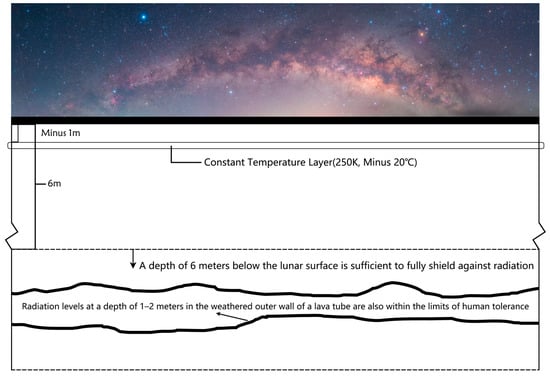
Figure 2.
Schematic diagram of lunar underground space research background (drawn by the author).

Table 1.
Representative Cases of Underground Architecture on Earth Designed to Cope with Extreme Conditions.

Table 2.
Characteristics of the Earth, Lunar Surface, and Lunar Subsurface.
Although current research on extraterrestrial habitation often addresses both Mars and the Moon, the present study focuses exclusively on the Moon. This scope is determined by its strategic role within the future deep-space exploration framework and its distinctive environmental characteristics. From a macro-strategic perspective, the Moon, with an average distance of approximately 384,000 km from Earth and a round-trip travel time of about three days, offers clear advantages in transportation, communication, and logistics compared with Mars, which requires six to nine months for a single journey. Consequently, the Moon is widely regarded as humanity’s “forward outpost” and “relay station” for deeper space exploration, serving multiple functions such as technology validation, resource transfer, emergency return, and communication relay. In terms of environmental features, while Mars possesses a thin atmosphere, a day-night cycle similar to Earth’s (approximately 24 h and 37 min), and is often envisioned as a potential site for long-term settlement, the Moon presents unique advantages in geological structure and construction feasibility. Recent remote sensing and simulation studies indicate the existence of extensive lunar lava tube systems, whose diameters may exceed those on Earth by several hundred to over a thousand times, with internal volumes reaching the scale of billions of cubic meters [,]. These naturally formed subsurface cavities offer stable thermal conditions and significantly mitigate risks from radiation, micrometeorite impacts, and extreme diurnal temperature fluctuations. They thus provide favorable conditions for establishing research bases and habitation modules. Therefore, compared with Mars, the exploitation of lunar subsurface space demonstrates greater practical feasibility and strategic priority at the current stage. Concentrating on the utilization of lunar underground space aligns with the phased development logic of the Earth–Moon–Mars spatial architecture and provides a robust experimental platform and evolutionary path for the long-term survival of humankind in space.
Based on the geological and strategic foundations outlined above, studies have emphasized the necessity of integrating Bioregenerative Life-Support Systems (BLSS) into lunar habitat design [,]. In extreme and enclosed environments such as subsurface lunar habitats, the sustainability of human life depends not only on structural protection and environmental control but also on maintaining ecological stability and recycling essential resources, including oxygen, water, and nutrients. The development of BLSS requires an interdisciplinary convergence of biology, ecology, and systems engineering to establish a closed-loop ecosystem capable of long-term operation within a confined space. Terrestrial analog experiments provide valuable insights into the feasibility and challenges of such systems. The Biosphere 2 experiment in the United States demonstrated both the potential and limitations of maintaining a self-sustaining ecological balance on Earth. The European Space Agency’s (ESA) Micro-Ecological Life Support System Alternative (MELiSSA) project further advanced this field by developing a regenerative artificial ecosystem suitable for long-duration missions []. Similarly, the Mars 500 project in Russia [] and the Hawaii Space Exploration Analog and Simulation (HI-SEAS) in the United States [] have generated empirical data on human adaptation, resource management, and ecological feedback in long-term confinement. Incorporating lessons from these terrestrial analog experiments into lunar habitat planning helps bridge the gap between conceptual design and operational feasibility, fostering a more holistic and interdisciplinary understanding of lunar subsurface living systems. This integration of architectural, ecological, and life-sciences research is essential for ensuring the technical viability and human sustainability of future lunar habitats.
This paper begins with an overview of the development history of lunar underground space utilization, leading to the proposal that the optimal site for establishing human living areas on the Moon should be located beneath the lunar surface. It then presents the principles that should guide the utilization and construction of lunar underground space, along with a conceptual vision for its future development. Finally, based on the concept of adaptive design, adaptive design strategies for lunar underground space utilization are proposed. Figure 2 illustrates the background of research on lunar underground space.
2. Development History of Research on Lunar Underground Space Utilization
Since the first successful manned lunar landing, with the advancement of science and technology, lunar resource exploration has become a crucial step in humanity’s efforts to explore the Moon and incorporate it into human activity. As exploration of the lunar spatial environment and resources continues, the utilization of lunar underground space has emerged as the next important objective for lunar exploration (as shown in Figure 3).
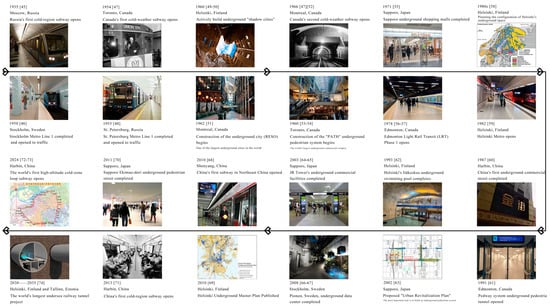
Figure 3.
Development History of Underground Space in Cold Region Cities (drawn by the author) [,,,,,,,,,,,,,,,,,,,,,,,,,,,,,]. The frame means time sequence.
Throughout the 20th century, various lunar base design proposals were put forward, some of which considered locating the base within lava tubes (as shown in Figure 4). In 1966, Johnson R.W. proposed the LESA lunar base concept, a semi-permanent facility capable of accommodating six crew members []. In 1985, Burke J.D. proposed a base design situated inside a polar crater cave on the Moon, utilizing solar reflectors to channel sunlight into the tunnels and incorporating structures to shield against cosmic radiation []. In 1991, Moore G.T. proposed a multi-level base design that included living quarters, research areas, mission control, and other supporting facilities [] (Figure 5).
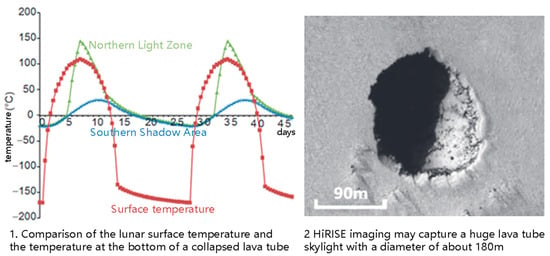
Figure 4.
Surface temperature as a function of local time illustrates that a shadowed area (blue) and an illuminated area (green) in the bottom of a hole of 50 m in diameter and depth, located in 15° N, and at a vicinity surface (red) of the Marius Hills Hole. The bottom of the hole and the vicinity surface are assumed to be covered by a thin regolith layer of 2 cm with albedo of 0.1 and thermal emissivity of 0.9 [,] “Reprinted with permission from Ref. []. 2023, Qiu X”. “Reprinted with permission from Ref. []. 2018, Xiao L”.

Figure 5.
Previous Cases of Lava Tube-Based Lunar Research Stations ((Left): LESA Expandable Lunar Base; (Center): Cave Base in the Montes Rook Ring Mountain; (Right): Multi-layer Structured Lunar Base) (drawn by the author).
In 2002, based on data from the Apollo missions, Angelis et al. [] developed models of the lunar regolith and bedrock to analyze and calculate the radiation dose received on the lunar surface. Their results showed that at a depth of 6 m below the surface, radiation could be completely shielded. Additionally, the weathered layer on the outer walls of lava tubes, with a thickness of 1 to 2 m, was found to have radiation levels within the range acceptable for humans, thereby confirming the strong shielding effect of lava tubes against particle radiation and their potential as sites for future lunar scientific research bases.
In 2019, Song Jinghua and colleagues [] proposed a conceptual plan for building a lunar base utilizing lava tubes. Figure 6 illustrates a semi-buried lunar base concept, suggesting that the construction of lunar bases could explore the use of natural lava tubes or excavated underground spaces.
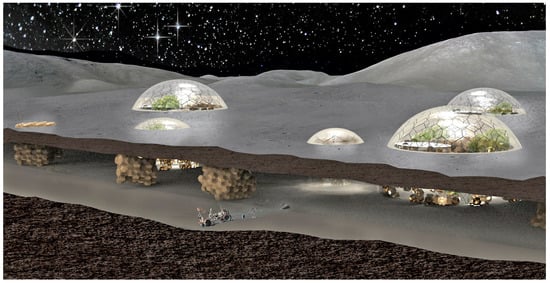
Figure 6.
Semi-buried lunar base scenario []. “Reprinted with permission from Ref. []. 2019, Song J H”.
In 2020, Xie Heping [] and his team, starting from the geological structural characteristics of the Moon and the features of its surface temperature variations, comprehensively considered factors such as lunar latitude and the thermal conductivity of regolith and bedrock. Focusing on the constant-temperature properties of the lunar subsurface thermal layer and its temperature range variation with latitude, they proposed concepts for the utilization of lunar underground space. These include developing human bases in the lunar constant-temperature layer, constructing underground orbital transportation systems, creating storage facilities for living organisms, and establishing thermal energy storage on the Moon. Figure 4 illustrates the conceptual vision for lunar underground space.
In 2022, Mei Hongyuan [,] and his team, approaching the topic from an architectural perspective, proposed two lunar scientific research base design schemes: the “Clover” layout and the “China Star” layout. The “China Star” research base design utilizes the natural shielding conditions of an lunar pit and employs a method of backfilling with lunar regolith for construction. In terms of spatial arrangement, the design transforms the transfer corridor of the core module into a vertical configuration, thereby dividing the base into a surface level and two underground levels (B1 and B2), forming a two-layer underground space utilization model. Figure 6 presents the technical diagram of the “China Star” scheme.(Figure 7)
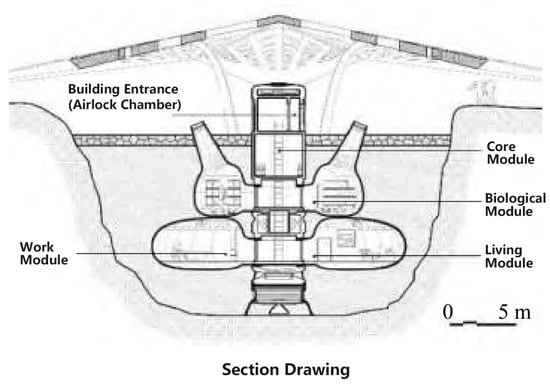
Figure 7.
Layout of “Red Star” []. “Reprinted with permission from Ref. []. 2022, Mei H Y”.
In 2022, Xie Gengxin and his team [] used cave environments in karst landscapes to simulate lunar lava tube environments. In 2023, Xie Gengxin’s team [] summarized the natural advantages of lunar lava tubes and the research progress of extraterrestrial farms. They provided an overview of the resource utilization technologies involved in establishing lunar farms, outlined the fundamental concepts for constructing lunar farms within lava tubes, and proposed layout planning for lunar farms based on lunar lava tubes. Additionally, they summarized the scientific challenges faced in building lunar farms, offering valuable references for future research on constructing lunar farms within lunar lava tubes. Figure 8 shows a conceptual diagram of a lunar farm/base based on lunar lava tubes.
In 2023, the Young Architects Competitions (YAC), in collaboration with the European Space Agency’s Planetary Caves Team, launched the Moon Station project []. Architects were invited to design lunar bases within the Lacus Mortis Pit and the interconnected underground lava tubes. The Lunar Tardigrade project proposed a modular and expandable habitat capable of moving within lunar lava tubes. The structure adopts a tracked suspension system and is constructed with a shape-memory alloy framework combined with 3D-printed lunar regolith walls, achieving both environmental adaptability and research functionality. This concept provides a novel vision for future lunar subsurface habitation and resource utilization. The Lunae Abyssi project envisioned a settlement composed of shell units with distinct functions. Each unit integrates prefabricated aluminum modules from Earth with double-layer inflatable envelopes, combining structural efficiency and adaptability. The Blooming project proposed a clustered habitat system in which individual modules are connected through a central core. Once deployed, each “bloom” extends along the lava tubes, taking advantage of the Moon’s natural cave systems. As the interior spaces become fully occupied by living and research facilities, the lava tubes themselves could transform into thriving subterranean cities (Figure 9).

Figure 8.
Concept map of lunar farm/base in lunar lava tube []. “Reprinted with permission from Ref. []. 2023, Xie G X”.

Figure 9.
Representative Award-Winning Proposals from the 2023 YAC “Moon Station Competition []. Reprinted with permission from open access online competition.
In 2024, Pan Wente and colleagues [] conducted research on the design of a suspended lunar permanent base utilizing the upper wall of lava tubes, aimed at the long-term construction of a permanent lunar base from an architectural perspective. The upper wall of the lava tube, being the closest space within the tube to the lunar surface, facilitates integration between internal facilities and surface installations. Additionally, the Moon’s low gravity makes it feasible to suspend the base from the upper rock walls. Figure 10 illustrates a conceptual design of an inflatable, expandable lunar permanent base.
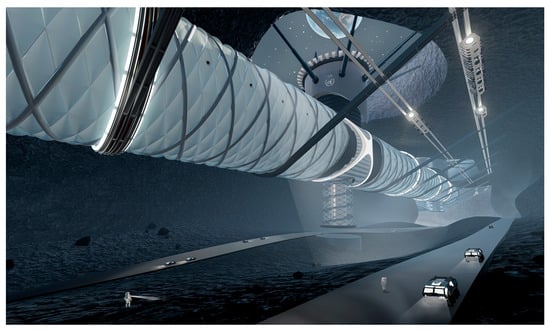
Figure 10.
Visualization of a Permanent Lava Tube Lunar Base []. “Reprinted with permission from Ref. []. 2024, Pan W T”.
From the development of planning, design, and construction on Earth’s surface to the design of underground spaces, and from the exploration and practice of lunar surface architecture to the future development and utilization of lunar underground space, the evolution of lunar architecture shows a trend toward diversification and greater depth. Compared to surface construction, building in lunar underground spaces offers numerous advantages. Underground spaces can effectively shield against external environmental factors such as radiation, temperature fluctuations, and micrometeorite impacts, providing a safer and more stable environment for human habitation and work. Additionally, underground spaces can make use of lunar soil resources to achieve self-sufficiency and sustainable development. Building on previous research on lunar habitats and the utilization of underground space, we propose the concept of a Lunar Underground Ecological City. This integrative approach envisions establishing long-term human residence on the Moon by leveraging subterranean environments to provide stable infrastructure for scientific research, resource development, and daily living. The concept emphasizes environmental adaptability, structural efficiency, and sustainable resource utilization, serving as a guiding framework for phased development.
3. Conceptual Vision for the Future Development of Lunar Underground Space Utilization
The development and utilization of lunar underground space should proceed in a planned, step-by-step, and orderly manner, based on comprehensive analysis and evaluation of lunar geological conditions, temperature profiles, near-lunar space environment, lunar surface environment, as well as deep lunar exploration technologies, deep lunar engineering sciences, and deep lunar resources. Drawing on previous experience from terrestrial underground space development, insights from Antarctic and other extreme environment habitats, and studies on lunar and Martian base construction proposed by NASA [], ESA, and Chinese space agencies [], as well as relevant academic research on resource utilization (ISRU) [,] and critical regionalism in architecture [], this paper synthesizes these references as a foundation for lunar underground space planning. On this basis, this paper proposes five fundamental principles to guide future lunar underground space utilization, along with a conceptual framework outlining different stages and levels of development through the 1.0 to 4.0 eras of lunar underground space utilization.
3.1. Principles to Guide Future Utilization of Lunar Underground Space
In exploring the utilization of lunar underground space and promoting its gradual development, five key principles are proposed to guide future lunar underground space utilization: the EarthMoon Integration Principle, Environmental Protection Principle, Utilization Principle, WinWin Cooperation Principle, and Sustainable Development Principle. These principles aim to ensure that this grand endeavor is both scientific and sustainable, providing guidance across all stages of development—from initial point-based facilities (1.0) to linear (2.0), areal (3.0), and finally large-scale, three-dimensional underground ecological cities (4.0)—by informing design, construction, resource use, environmental protection, collaboration, and long-term sustainability.
(1) EarthMoon Integration Principle
The future development and utilization of lunar underground space is a complex and large-scale system. The construction and operation of scientific research bases on the Moon and other extraterrestrial bodies [] involve multiple aspects and interdisciplinary knowledge, including surface exploration, material production, resource utilization, energy development, information and communication infrastructure, lunar base construction, transportation and operations, ecological systems, and life support. This requires adherence to the Earth–Moon Integration Principle, which fully leverages the dual advantages of cutting-edge terrestrial technologies and lunar resources. China’s lunar base construction goals encompass both scientific and engineering objectives []. In the near term, engineering goals include EarthMoon transportation facilities, long-term surface support facilities, surface transportation and operational facilities, lunar scientific facilities, and ground support and application facilities.
With the advancement of construction technologies and expansion of project scale, lunar base development will proceed through three stages: terrestrial prefabrication, EarthMoon integrated construction, and lunar construction. The first two stages rely on fabrication and launch from Earth, with structures assembled or deployed in extraterrestrial space. Based on different mission objectives, site selection according to terrain utilization, and technological feasibility, an overview of lunar base architectural types has been proposed [] (Figure 11).
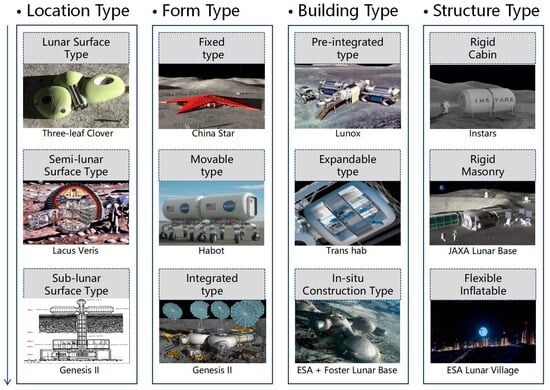
Figure 11.
Overview of Architectural Scheme Types for Lunar Bases (drawn by the author).
China’s “National Space Science Medium- and Long-Term Development Plan (2024–2050)” identifies “deep lunar material exploration” as one of the priority development directions. Therefore, lunar base construction should fully integrate technological breakthroughs and practical applications from numerous terrestrial fields such as energy, materials, intelligent construction, and life sciences. Additionally, it should closely incorporate key deep-earth technologies related to underground ecosystem construction [], including simulated sunlight, intelligent air regeneration, clean water recycling systems, and underground ecological vegetation; deep-earth energy self-balancing technologies; and deep-earth waste treatment and recycling technologies. Together, these efforts aim to achieve an effective integration of Earth and lunar underground space utilization.
At the practical level, the Earth–Moon integration principle emphasizes that the planning and construction of lunar bases should form a mutually supportive technological loop between Earth and the Moon. Ground laboratories and simulated environments can serve as important platforms for validating new technologies and assessing risks. For example, space medicine research can initially be conducted in Earth-based simulators, including testing robotic surgical procedures and analyzing post-operative recipient feedback, to preliminarily verify the reliability and feasibility of the systems before gradually extending them to lunar applications []. In terms of construction processes, coordinated task allocation between Earth and the Moon is crucial: Earth can focus on complex manufacturing, remote control, and system integration, while the Moon can utilize resources for structural assembly and phased expansion, thereby achieving a balanced optimization of resource use and energy efficiency.
(2) Environmental Protection Principle
With the continuous advancement of human lunar exploration technologies, the development of lunar resources is an anticipated future. To ensure the sustainable use of lunar resources and protect the lunar environment, it is essential first to establish and improve legal frameworks governing lunar resource utilization and environmental protection []. The “Agreement Governing the Activities of States on the Moon and Other Celestial Bodies”, which came into force in 1984, states in Article 11 that the Moon and its resources are the common heritage of all humankind, and no nation may claim sovereignty over them. Article 3 prohibits the deployment of military facilities, testing of weapons, or establishment of military bases on the Moon. The 1967 Outer Space Treaty also established the environmental protection principle, requiring countries to avoid harmful contamination of celestial bodies during exploration and to prevent adverse changes to Earth’s environment caused by extraterrestrial materials, taking necessary measures accordingly [,].
During lunar underground space utilization, strict measures must be taken to prevent the introduction of terrestrial biological materials into the lunar environment, avoiding potential contamination or damage caused by Earth microbes or pollutants to the lunar system. At the same time, physical and chemical pollution from lunar resource mining and smelting operations must be prevented to avoid dust and chemical dispersion that could harm the Moon’s pristine environment []. When conducting underground drilling and excavation, the impacts on lunar geological structures must be carefully considered to avoid irreversible damage to the Moon’s original geological formations and ecological balance [].
Additionally, reports indicate that nearly 200 tons of human-made debris, including discarded probes, have been left on the Moon. Therefore, future lunar base construction must also address waste management []. Base planning and design should include facilities for waste collection and processing to ensure proper disposal and recycling. Developing sustainable resource recycling technologies to minimize waste generation is crucial for achieving long-term lunar habitation and sustainable development.
(3) Utilization Principle
Fully leverage the favorable lunar environment while avoiding adverse external factors by utilizing the natural shielding conditions formed by lunar features such as impact craters (including blast craters), mare pits, and highland caves for lunar underground space utilization. Lunar craters are typically surrounded by circular mountain rings ranging from 300 to 7000 m in height, with flat floors []. These can be enclosed and pressurized with cable-suspended structures or large-span membrane structures to shield against the lunar environment and create spacious “outdoor” habitats. Lunar lava tubes, as natural caves on the Moon, can reach hundreds of meters in size. They not only provide protection from external conditions but also maintain relatively stable temperature and humidity. Once their open ends are sealed, they become safe and stable environments.
When developing lunar underground space, emphasis should be placed on exploiting lunar mineral resources such as regolith, bedrock, metals, and non-metals, achieving resource extraction and construction directly on the Moon. Lunar regolith is the primary raw material for extraterrestrial construction. After processing, it can produce materials including concrete-like composites [,,,,], sintered bricks, glass and fibers, metals [,], and alloys. Using regolith as a protective layer in lunar architecture greatly reduces cyclic stresses caused by temperature fluctuations and improves material durability against radiation []. Additionally, 3D printing with regolith-based cementitious materials [,] enables construction.
Moreover, lunar water resources are becoming a vital strategic asset for future lunar base construction and long-term surface habitation and scientific activities. Methods for water extraction are recognized as key technologies in lunar exploration []. Currently, multiple deposits of water ice have been confirmed in permanently shadowed regions of craters above 70° latitude near both lunar poles. Table 3 summarizes relevant information on utilization of lunar resources.

Table 3.
Utilization of Lunar Resources.
(4) WinWin Cooperation Principle
Lunar underground space is a resource for all humanity, and its utilization is a global issue. Collaborative exploration and development of lunar underground space by all countries exemplify the spirit of building a community with a shared future for mankind. From this perspective, it is essential for leading domestic and international organizations and groups to engage deeply in aerospace exchanges and cooperation. This collaboration should focus on innovation across four levels: lunar space exploration, development and application concepts, interdisciplinary integration, and cutting-edge technologies []. Joint efforts should be made to develop and implement relevant standards and regulations, share technologies and resources, and achieve mutual benefits [].
At the same time, it is important to expand the framework for international cooperation based on the principles of consultation, contribution, and shared benefits. This includes promoting the establishment of international ethical guidelines and legal frameworks for lunar development to ensure that lunar exploration and utilization activities comply with international principles and prevent exploitative resource extraction. By clarifying the scope of activities, responsibilities, and dispute resolution mechanisms through improved legal frameworks, cooperation can be promoted over competition, helping to establish a fair and reasonable global governance system for EarthMoon space.
(5) Sustainable Development Principle
Lunar underground space is an irreversible natural resource; once utilized, it cannot be restored. Therefore, the process of exploiting lunar underground space must emphasize rational resource use and environmental protection, ensuring sufficient space and opportunities remain for future exploration and utilization. As the world rapidly advances in information technology innovation, ushering humanity into an era of digitalization, networking, and intelligence, the scale and scope of deep space exploration are expanding. The utilization of lunar underground space should follow a path of green, information-driven, and intelligent development, ultimately achieving sustainable development.
3.2. Conceptual Vision for the Future Development of Lunar Underground Space Utilization
Xie Heping and others proposed a vision for a future underground ecological city [], emphasizing that the core of such a city lies in creating a relatively independent ecosystem capable of achieving energy self-balance. The design adopts a layered structure, dividing the future underground city into five levels:
1. Underground orbital transportation and civil defense shelter facilities (less than 50 m depth); 2. Underground livable city (50 to 100 m depth), forming an independent deep-earth self-sustaining ecological system; 3. Underground ecosphere and strategic resource reserves (100 to 500 m depth); 4. Underground energy circulation system (500 to 2000 m depth); 5. Deep-earth scientific laboratories and deep-earth energy extraction (greater than 2000 m depth).
As illustrated in Figure 12, this future underground city can realize deep-earth atmospheric circulation, energy supply, and ecological reconstruction, ensuring its safe and sustainable operation. This conceptual framework offers a novel approach for the planning and layout of future underground cities.
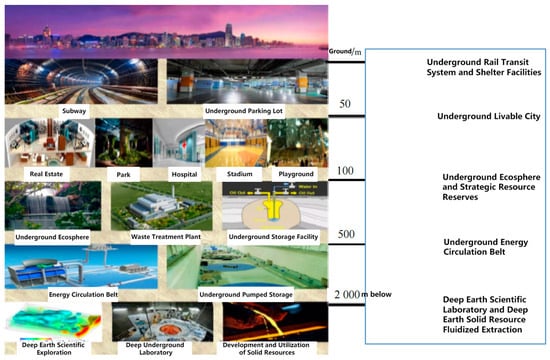
Figure 12.
The vision of future underground ecological city proposed by Xie Heping. [] “Reprinted with permission from Ref. []. 2013, Xie H P”.
Building upon Xie Heping’s concept of the underground ecological city and following the principles for future lunar underground space utilization proposed in this paper, a forward-looking framework is put forward to envision the development of lunar underground space utilization through different stages and levels spanning the 1.0 to 4.0 eras.
(1) Lunar Underground Utilization Development 1.0: Point-Based Underground Facilities.
In 2016, China proposed the International Lunar Research Station program. The functional requirements for the initial lunar base aim to provide a safe and stable living environment for crewed lunar missions, supporting short-term human habitation and long-term autonomous operation. Based on the lunar underground environment, available resources, and project feasibility, constructing small-scale, point-based underground facilities represents the 1.0 era of lunar underground space utilization.
This stage should fully leverage the distribution of eight typical lunar lava tube caves discovered by researchers—for example, two typical lava tubes spanning from Mare Crisium to Mare Serenitatis are approximately 580 km apart—to build point-like underground facilities such as communication hubs, energy stations, and habitation modules to meet initial functional demands, thereby realizing the envisioned construction tasks within lunar lava tubes [].
The construction plans for initial lunar base facilities adhere to principles of intensive layout suitable for early development stages and utilization. They integrate terrestrial construction techniques with lunar resource advantages, following a phased construction approach: from Earth-based prefabrication to on-lunar construction, from single units to integrated systems, from low-technology to high-technology solutions, and from passive to active construction methods []. At this stage, technical considerations include minimizing lunar dust intrusion and abrasive particle wear on equipment and living spaces, implementing airlock filtration systems, and ensuring sealed modular connections for long-term operability. Figure 13 presents a bird’s-eye view concept of the point-based lunar underground facilities, while Figure 14 shows the sectional view.
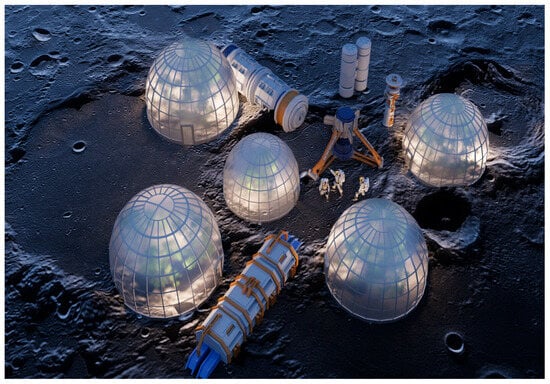
Figure 13.
A bird’s-eye view of the concept of point-shaped underground space facilities (drawn by the author).
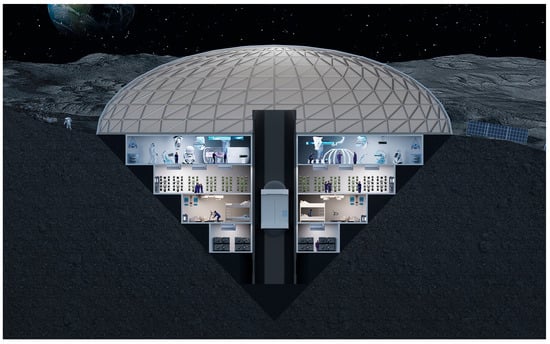
Figure 14.
Conceptual cross-section of point-shaped underground space facilities (drawn by the author).
(2) Lunar Underground Utilization Development 2.0: Linear Underground Facilities.
Site selection for lunar underground space utilization is the primary step in constructing lunar underground facilities. Smooth mare regions, large impact craters, and subsurface lunar lava tubes are all considered potential candidate sites for lunar underground facility development. Due to the current limited understanding of the Moon’s geological structure, construction based on large impact craters still faces significant technical challenges. In contrast, abundant exploration data indicate that the natural environment inside lava tubes offers favorable conditions for human habitation and operations, making them the preferred choice for lunar underground space utilization.
By reinforcing and modifying lava tubes, various functional linear underground facilities can be constructed, marking the 2.0 era of lunar underground space utilization. This stage should fully utilize the largest lava tubes discovered by researchers, which exhibit linear distributions with diameters up to 304.8 m and lengths exceeding 40 km. Functional linear underground facilities to be developed include lunar subterranean transportation corridors, underground energy pipelines, and strip-shaped residential living areas.
These linear underground facilities serve as essential links connecting the point-based underground facilities on the Moon and represent a fundamental and critical form of lunar underground space utilization. At this stage, additional technical challenges include managing thermal stresses along long underground corridors, optimizing structural interfaces between modules, and integrating continuous life-support and environmental monitoring systems to maintain stable operation. Figure 15, taken from the article “Ideal Lunar Base—Lava Tube Caves” by Wang Jiang et al. in China National Astronomy magazine, illustrates this concept. Figure 16 presents a cross-sectional example of a lunar linear underground facility design.

Figure 15.
Cross-section and longitudinal sections of the lava tube tunnel. [] “Reprinted with permission from Ref. []. 2018, Xiao L”.
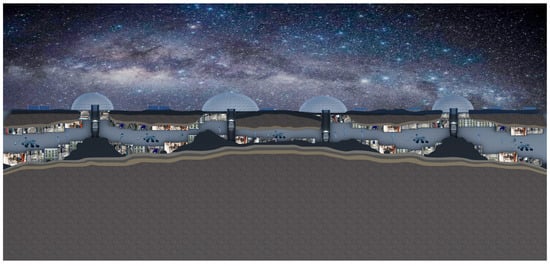
Figure 16.
Conceptual cross-section of linear underground space facilities (drawn by the author).
(3) Lunar Underground Utilization Development 3.0: Areal Underground Facilities.
Current research on lunar geological structures faces challenges due to the lack of information about the Moon’s deep subsurface and the unclear potential for deep lunar resource utilization. However, lunar regolith, with its extremely low thermal conductivity, creates a stable temperature zone about 1 m below the surface, maintaining a constant temperature of approximately −20 °C []. This stable thermal environment can provide suitable conditions for human survival and activities. Based on the temperature range of this lunar thermal stable layer and geological conditions, the development of areal underground facilities—composed of interconnected point-based and linear underground spaces—marks the 3.0 era of lunar underground space utilization. This stage envisions the excavation and construction of underground spaces within the lunar thermal stable layer, enabling facilities that support lunar underground human bases, subterranean transportation systems, biological storage, and thermal energy storage. Key considerations include designing systems for maintenance and repairability, modular replacement of structural and mechanical components, automated monitoring for structural or environmental issues, and provisions for dust mitigation and wear reduction in human-occupied spaces. A conceptual example of lunar areal underground facilities is illustrated in Figure 17.

Figure 17.
Case concept of planar underground space facilities (drawn by the author).
(4) Lunar Underground Utilization Development 4.0: Three-Dimensional Underground Ecological City.
The development of a large-scale, networked, three-dimensional lunar underground city is envisioned as the 4.0 era of lunar underground space utilization. This city would be constructed by connecting multiple developed underground layers across a broad lunar region through various horizontal and vertical corridors, forming an integrated subterranean urban network. At this stage, human knowledge has advanced across multiple disciplines—including lunar surface exploration, material production, resource utilization, energy development, information and communication infrastructure, lunar base construction, transportation operation, ecological development, and life support systems—laying a solid foundation for building a lunar underground ecosphere. This enables the creation of green, ecological, and healthy three-dimensional livable cities beneath the lunar surface. Future three-dimensional lunar underground ecological cities will feature simulated sunlight, intelligent air regeneration systems, water resource extraction, and the establishment of underground ecological vegetation systems. They will also harness material and environmental resources for energy development, implement harmless waste treatment, resource recycling, and permanent disposal technologies. At this stage, considerations include quantified radiation shielding, thermal stress management in multi-layer structures, long-term ecological system maintenance, and repairability of large-scale underground facilities to ensure sustainable operation over decades. Figure 18 illustrates the concept of a lunar underground ecological city.
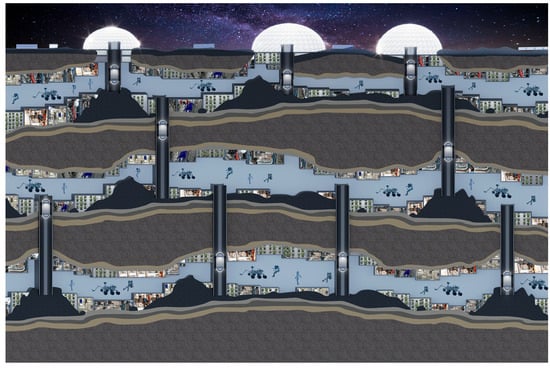
Figure 18.
Case concept of planar underground space facilities (drawn by the author).
4. Adaptive Design Strategies for Future Lunar Underground Space Utilization
4.1. Definition of Adaptive Design
The term “adaptability” originates from the Latin word aptus in the early 14th century, meaning “fit” or “suitable.” The word adapter refers to “making something suitable for a certain purpose.” In modern usage, “adaptability” refers to the property of a subject changing in response to environmental or other objective factors to better conform to reality.
Research on architectural adaptability dates back to James Douglas’s book Building Adaptability []. Architect Hoberman viewed adaptable architecture as performance-based buildings that adjust their form and function in real time to adapt to environmental changes []. Architect Graham, in his article Adaptive Design—Principles and Basic Strategies, described architectural adaptability as the ability of buildings, components, and materials to remain efficiently utilized to the greatest extent possible [].
Although scholars worldwide have not agreed on a unified definition of adaptability, the broad consensus is that it refers to a building’s capacity to adjust over time to new environments, thereby extending its usable life, enhancing the environmental quality of its surroundings, and achieving social value. Zhang Feng [], synthesizing existing definitions and research, defined architectural adaptability as the building’s ability to effectively regulate itself to meet the evolving needs of users and environments, thus maximizing its value throughout its lifecycle.
Mei Hongyuan [] analyzed constraints and practical issues in cold-region architecture design in Northeast China and proposed adaptability strategies from environmental, climatic, and economic perspectives. Liu Yiqing et al. [] studied design principles and strategies for lunar architecture under extreme environments. Ren Fei et al. [] researched design strategies to enhance habitability in space architecture under extreme conditions. Layla van Ellen et al. propose a “Rhythmic Architecture” strategy that enables buildings to adapt to environmental rhythms such as temperature cycles and circadian patterns. It demonstrates adaptability as an architectural response synchronized with dynamic environmental changes [].
From these definitions, research, and practices, it is clear that the adaptability of lunar underground space development and facility construction broadly refers to the ability of lunar underground structures to be adjusted over time to changing functional requirements, spatial dynamics, and environmental conditions, thereby prolonging their service life and maximizing their value through adaptive capacity [].
4.2. Adaptive Design Strategies for Lunar Underground Space Utilization
For the future utilization of lunar underground space, the core concept of adaptive design strategies is based on the Moon’s geological, thermal, and climatic characteristics, as well as current conditions and developmental needs. By exploring breakthroughs and practices in technologies related to lunar energy, materials, life support, and more, these strategies focus on the intrinsic mechanisms of natural constraints and spatial form adaptability. They aim to address the various development stages of lunar underground space utilization through adaptable spatial forms in point, line, surface, and volume configurations. Combining the five principles of lunar underground space utilization with the 1.0 to 4.0 development framework, nine types of adaptive design strategies are proposed around three key aspects: space, environment, and climate (see Table 4). Each strategy possesses distinct and independent features, yet they interact and function collectively. These nine design strategies can serve as valuable references for designers during the initial phases of planning future permanent lunar bases with adaptive capabilities. In terms of development stages, certain strategies are particularly critical at different phases. During the early 1.0–2.0 stages, strategies emphasizing spatial utilization (A), modular facilities (B), and structural stability (C) are essential to establish safe and functional point- and linear-based underground facilities. In the later 3.0–4.0 stages, strategies focusing on adaptive building materials (D), high-efficiency insulation (E), circular ecosystem establishment (F), passive energy saving (G), diverse ecological landscapes (H), and renewable energy utilization (I) become increasingly important to support large-scale, interconnected, and sustainable underground cities. This phased prioritization helps guide the practical implementation of adaptive design strategies in alignment with the 1.0–4.0 development framework.

Table 4.
Adaptive Design Strategies for Lunar Underground Space Utilization.
4.2.1. Spatial Adaptability Design Strategies
Spatial adaptability is reflected in spaces better meeting user needs, improving space utilization efficiency and flexibility, emphasizing the ability of spaces to change in response to demands. The corresponding design strategies for spatial adaptability mainly include:
(1) Utilization of space. The Moon contains abundant usable geological features, such as lunar pits and lava tubes, which can provide shelter for lunar exploration equipment and living space for humans on the Moon. When envisioning future lunar underground human bases, lunar underground transit systems, lunar life form storage, and lunar thermal energy storage [], the functional requirements should fully leverage the favorable lunar environment by adopting utilization strategies. Special attention should be given to designing interfaces that minimize dust intrusion and particle wear on equipment and living areas, including airlock filtration and sealed modular connections.
(2) Modularization of Facilities. Spatial adaptability generally includes “spatial scalability” and “design adjustability.” To reduce research and production costs and improve product utilization, lunar underground space facilities should adopt modular design. This approach facilitates long-term iterative development, enables orderly extension of underground spaces, and allows flexible and dynamic interaction between spaces, thereby expanding the functional use of lunar underground space []. Modular connections should also account for thermal expansion/contraction and differential stresses at material interfaces caused by extreme lunar temperature cycles, ensuring reliability without compromising adaptability.
(3) Structural Stability and Reliability. Future lunar space utilization will rely on the use of geological resources and underground excavation within the lunar thermal stable layer, necessitating ensured structural stability and reliability. For utilized wall-attached caves, sprayed reinforcement is required, which demands breakthroughs in intelligent robotic operations on the Moon. For secondary prefabricated lining structures in utilized spaces, advancements in Earth–Moon integrated construction technologies are essential. Future underground excavation within the thermal stable layer will require innovations in intelligent autonomous construction technologies and effective humanrobot collaboration on the lunar surface. Structural systems should be designed to allow maintenance and repair, including robotic-assisted interventions, modular replacement, and monitoring of thermal/structural stress over time.
4.2.2. Environmental Adaptability Design Strategies
Environmental adaptability is reflected in energy efficiency and health considerations, and it also serves as a fundamental approach to environmental protection. The corresponding design strategies mainly include:
(1) Adaptable Building Materials: Concrete made from lunar basalt exhibits compressive and tensile strengths approximately ten times greater than conventional concrete, making it the preferred material for lunar construction. Lunar regolith can be sintered into ceramic materials through microwave heating, and due to its high silicate content, ultra-pure glass can be manufactured in a vacuum environment. Additionally, the Moon contains abundant rare metals such as titanium, iron, chromium, and nickel, which can be used in structural design and components to reduce launch load pressures and aid the development of new materials and optimized structural designs [].Material selection should also consider radiation shielding performance and wear resistance against lunar dust, ensuring long-term durability under extreme conditions.
(2) Use of Highly Efficient Insulating Lunar Regolith: Due to its extremely low thermal conductivity, lunar regolith forms a thermal stable layer at about 1 m depth, maintaining a temperature around 250 K (−20 °C) that provides a relatively suitable environment for human survival. Leveraging the natural insulation properties of lunar soil helps maintain internal temperature stability and reduces energy consumption []. Insulation design should further quantify radiation attenuation for cosmic rays and solar particle events, beyond general protective statements.
(3) Construction of Closed-Loop Ecological Systems: To achieve sustainable utilization of lunar underground space, establishing a closed-loop, recyclable ecological system dependent on lunar surface resources is the ultimate goal. Continuous research is needed to solve key technological challenges related to lunar sunlight simulation, ecological air regeneration, clean water recycling, ecological vegetation, and energy self-circulation []. Ecological system design should include protective measures for dust toxicity, easy maintenance, and repairability under lunar conditions.
4.2.3. Climate Adaptability Design Strategies
Climate adaptability is reflected in how lunar underground facilities respond to changing lunar climate conditions through corresponding adaptive designs to ensure stable performance and comfortable indoor environments. The design strategies for climate adaptability mainly include:
(1) Passive energy-saving of the building itself. Maximizing the use of the Moon’s natural conditions to reduce energy consumption and achieve efficient utilization—for example, using the insulating properties of lunar regolith to form a natural thermal barrier; retaining and properly treating daylighting windows to effectively utilize direct sunlight and enhance comfort in lunar spaces []. Thermal barrier design should also integrate radiation shielding and consider thermal stress at structural interfaces.
(2) Creating diverse ecological landscapes. In 2018, the “Biological Popular Science Experiment Payload” aboard the Chang’e-4 mission grew the first plant sprout on the Moon’s surface after enduring harsh conditions such as low gravity, strong radiation, and large temperature differences—marking the first “green life” on the lunar surface. Ecological vegetation can regulate carbon-oxygen balance, achieve temperature control and microclimate regulation, and create a distinctive lunar underground environment. Vegetation and ecological systems should be designed with dust mitigation and maintainability in mind, enabling replacement or repair under lunar conditions.
(3) Utilization of renewable energy. The extreme lunar environment also offers abundant environmental resources such as large temperature variations, plentiful solar energy, solar wind, and cosmic rays. Harnessing these abundant resources and environmental supports can sustain lunar energy supply, providing continuous power for underground lunar facilities []. Energy infrastructure should allow maintenance, modular replacement, and robotic servicing to ensure long-term operational reliability under extreme conditions.
5. Conclusions
This study reviewed the historical development of human exploration of underground space and examined its applications and implications across different environmental contexts. The findings suggest that underground spaces hold comprehensive potential in terms of protection, safety, climate regulation, and efficient land use. Their evolution is closely linked to humanity’s adaptive responses to environmental constraints and pressures related to resources and climate. In extreme terrestrial environments—such as hot arid zones and cold regions—the use of underground space reflects an adaptive design mindset that leverages natural conditions, offering valuable references for the architectural strategies of future extreme environments.
With the advancement of space technology, lunar exploration and development have gradually become significant pathways for the continuation and evolution of human civilization. Owing to its stable thermal conditions, natural radiation shielding, and abundant potential resources, the lunar subsurface is considered a promising environment for the establishment of long-term bases and even future permanent habitats. Based on a review of current research progress, this paper proposes five guiding principles for the rational utilization of lunar underground space: the Earth–Moon Integration Principle, the Environmental Protection Principle, the Resource Utilization Principle, the Cooperation and Shared Benefit Principle, and the Sustainability Principle. These principles aim to provide a conceptual framework for future lunar development, ensuring that such endeavors proceed in a scientific and sustainable manner.
Furthermore, from a developmental perspective, this study outlines four progressive stages for the utilization of lunar underground space: Stage 1.0: Point-based underground facilities focused on scientific exploration and short-term habitation; Stage 2.0: Linear underground facilities forming basic interconnected networks; Stage 3.0: Surface-scale underground facilities enabling multifunctional base complexes; Stage 4.0: Three-dimensional underground ecological cities achieving long-term habitation and ecological self-sufficiency.
Building on the concept of adaptive design and integrating the five principles and four-stage framework, this paper proposes nine adaptive design strategies for future lunar underground space from three key dimensions: spatial organization, environmental control, and climate adaptability. These strategies aim to guide the planning of lunar architecture and promote an ongoing dialogue between extraterrestrial development and terrestrial architectural experience.
Overall, the study indicates an intrinsic continuity between the research and application of underground spaces on Earth and the Moon. Through the synthesis of historical practice, environmental adaptation, and future-oriented exploration, it can be observed that underground space is not only a response to survival challenges but also a manifestation of humanity’s evolving spatial utilization paradigm. Moreover, future research should focus on developing environmental simulation platforms, material prototypes, and digital adaptive models to optimize lunar underground habitat planning and construction. This approach will further enhance the integration of architecture, spatial engineering, and environmental science, highlighting the interdisciplinary nature of underground space research. As scientific exploration deepens and interdisciplinary collaboration expands, underground space research is expected to play an increasingly significant role in both terrestrial and extraterrestrial environments.
Author Contributions
Conceptualization, X.X.; methodology, X.X. and M.X.; writing—original draft preparation, X.X.; writing—review and editing, X.X. and M.X.; visualization, X.X.; supervision, M.X. All authors have read and agreed to the published version of the manuscript.
Funding
This research received no external funding.
Data Availability Statement
The data presented in this study are available on request from the corresponding author. The data are not publicly available due to privacy.
Conflicts of Interest
The authors declare no conflicts of interest.
References
- Constellation Program Overview. Available online: https://epizodsspace.airbase.ru/bibl/inostr-yazyki/nasa/2006/Connolly_Constellation_Program_Overview_%28Oct-2006%29.pdf?utm_source (accessed on 1 January 2020).
- China Aerospace Editorial. Peminov Talks About Russian Space Program. China Aerosp. 2007, 9–10. [Google Scholar]
- Kohtaro, M. Moon and planetary exploration in JAXA. In Proceedings of the 2nd Space Exploration Conference, Houston, TX, USA, 30 January–1 February 2006; Volume 12, pp. 1–10. Available online: https://www.scribd.com/document/350209/NASA-164272main-2nd-exp-conf-12-InternationalExplorationPerspective-KMatsumoto (accessed on 1 January 2020).
- Kohtaro, M. Robotic Lunar Exploration Scenario. JAXA Plan 2006, 5, 1–26. Available online: https://it.scribd.com/document/207163704/1-JAXA (accessed on 8 November 2025).
- Yu, D.Y.; Ge, Z.J.; Wang, N.D.; Xiao, L.; Lin, Z.J. Supposal for structure form of lunar base. J. Astronaut. 2012, 33, 1840–1844. (In Chinese) [Google Scholar] [CrossRef]
- Guo, L.L.; Wang, P.; Zhu, S.Y. Engineering for Manned Lunar Base; China Astronautic Publishing House: Beijing, China, 2013; ISBN 9787515905921. (In Chinese) [Google Scholar]
- Crawford, I. Why we should build a Moon Village. Astron. Geophys. 2017, 58, 6–18. [Google Scholar] [CrossRef]
- Pei, Z.Y.; Liu, J.Z.; Wang, Q.; Kang, Y.; Zou, Y.; Zhang, H.; Zhang, Q.; He, H.; Wang, Q.; Yang, R.; et al. Overview of lunar exploration and international lunar research station. Chin. Sci. Bull. 2020, 65, 2577–2586. (In Chinese) [Google Scholar] [CrossRef]
- Liu, J.J. New World Space Technologies—Lunar Space Station. Satell. Netw. 2020, 56–63. (In Chinese) [Google Scholar]
- Inflatable Habitation for the Lunar Base. Available online: https://ntrs.nasa.gov/api/citations/19930008253/downloads/19930008253.pdf?utm_ (accessed on 1 January 2020).
- Nowak, P.S.; Sadeh, W.Z.; Morroni, L.A. Geometric Modeling of Inflatable Structures for Lunar Base. J. Aerosp. Eng. 1992, 5, 311–322. [Google Scholar] [CrossRef]
- Hauplik-Meusburger, S.; Ozdemir, K. Deployable lunar habitation design. In Moon: Prospective Energy and Material Resources, 1st ed.; Badescu, V., Ed.; Springer: Berlin, Germany, 2012; pp. 469–502. [Google Scholar]
- Zhou, C.; Chen, R.; Xu, J.; Ding, L.; Luo, H.; Fan, J.; Chen, E.J.; Cai, L.; Tang, B. In-situ construction method for lunar habitation: Chinese Super Mason. Autom. Constr. 2019, 104, 66–79. [Google Scholar] [CrossRef]
- Ye, P.J.; Yu, D.Y.; Sun, Z.Z.; Shen, Z.R. Achievements and prospects of Chinese lunar probes. J. Deep Space Explor. 2016, 3, 323–333. [Google Scholar] [CrossRef]
- China National Space Administration. International Lunar Research Station Partnership Guide [EB/OL]. Available online: https://www.cnsa.gov.cn/n6758823/n6758838/c6812147/content.html (accessed on 16 June 2021).
- Zhu, E.Y.; Guo, L.L.; Chen, C. Conceptual design scheme of manned lunar base. Aerosp. Return Remote Sens. 2013, 34, 1–6. (In Chinese) [Google Scholar] [CrossRef]
- Guo, L.L.; Li, Z.J.; Qi, B.; Liang, L.; Ye, P.J. Integrated overall scheme and construction plan conception for manned lunar base. Aerosp. Return Remote Sens. 2014, 35, 1–10. (In Chinese) [Google Scholar] [CrossRef]
- Mei, H.Y.; Bao, W.M.; Yu, D.Y.; Liu, P.Y.; Wang, Y.S.; Pan, W.T.; Chen, Y.; Li, J.Y.; Gao, Z.Y.; Fei, T. Research on building plans design for future lunar base. J. Deep Space Explor. 2022, 9, 553–559. (In Chinese) [Google Scholar] [CrossRef]
- Liu, Y.Q.; Mei, H.Y.; Liu, P.Y.; Pan, W.T. The design strategy of habitat in lunar environment. Contemp. Archit. 2022, 21–24. (In Chinese) [Google Scholar]
- Ding, L.Y.; Zhou, C.; Gao, Y.Y.; Han, W.B. Progress and scientific-technical challenges in extraterrestrial construction research. J. Civ. Eng. 2024, 57, 26–42. (In Chinese) [Google Scholar] [CrossRef]
- Zhou, C.; Gao, Y.Y.; Qin, W.B.; Ding, L.Y. Development trend, objectives, and policy path of lunar base construction. Chin. Sci. Bull. 2025, 70, 3460–3469. (In Chinese) [Google Scholar] [CrossRef]
- Shi, X.B.; Li, Y.Z.; Huang, Y.; Wang, J. Conceptual design of lunar surface environment simulation system. Eng. Sci. 2006, 8, 48–52. (In Chinese) [Google Scholar]
- Feng, X.; Guo, Q. Lunar surface temperature real-time model. J. Remote Sens. 2017, 21, 928–938. (In Chinese) [Google Scholar] [CrossRef]
- Zhou, C.; Li, X.; Gao, Y.; Chen, R. Parametric design and optimization for lava tubes-like lunar arch habitation with large span. Space Habitat. 2025, 1, 100001. [Google Scholar] [CrossRef]
- Ma, Y.; Mei, H.; Xu, X.; Pan, W.; Wang, L. Computational morphogenesis method for the lunar shelter based on the principle of inverse hanging simulation and bi-directional evolutionary structural optimization. Acta Astronaut. 2026, 238, 377–390. [Google Scholar] [CrossRef]
- Kaplicky, J.; Nixon, D. A Surface-Assembled Superstructure Envelope System to Support Regolith Mass-Shielding for an Initial-operational-Capability Lunar Base. In Lunar Bases & Space Activities of Century; Lunar and Planetary Institute: Houston, TX, USA, 1985; p. 375. Available online: https://www.adsabs.harvard.edu/full/1985lbsa.conf.375K (accessed on 8 November 2025).
- Burry, J.; Latifi, M. Arcological City: Going Underground. Archit. Des. 2023, 93, 54–61. [Google Scholar] [CrossRef]
- Rezaee, R.; Vakilinezhad, R.; Shahzadeh, M. The “Shavadun” as an Ecological Solution for Architecture in a Hot Climate. WIT Trans. Ecol. Environ. 2009, 120, 303–313. [Google Scholar] [CrossRef]
- Xu, X.H.; Liang, X.G.; Ren, J.X. Numerical analysis of thermal environment of lunar surface. J. Astronaut. 2006, 27, 153–156. (In Chinese) [Google Scholar]
- Wagner, R.V.; Robinson, M.S. Distribution, formation mechanisms, and significance of lunar pits. Icarus 2014, 237, 52–60. [Google Scholar] [CrossRef]
- Lee, P. Possible lava tube skylights near the north pole of the moon. In Proceedings of Lunar and Planetary Science Conference, The Woodlands, TX, USA, 10–14 March 2025; Lunar and Planetary Institute: Houston, TX, USA, 2018; p. 2083. Available online: https://ui.adsabs.harvard.edu/abs/2018LPI....49.2982L/abstract (accessed on 8 November 2025).
- Qiu, X.; Ding, C. Radar observation of the lava tubes on the moon and Mars. Remote Sens. 2023, 15, 2850. [Google Scholar] [CrossRef]
- Sauro, F.; Pozzobon, R.; Massironi, M.; De Berardinis, P.; Santagata, T.; De Waele, J. Lava tubes on Earth, Moon, and Mars: A review on their size and morphology revealed by comparative planetology. Earth-Sci. Rev. 2020, 209, 103288. [Google Scholar] [CrossRef]
- Xiao, L.; Huang, J.; Zhao, J.W.; Zhao, J.N. Significance and preliminary proposal for exploring the lunar lava tubes. Sci. China Phys. Mech. Astron. 2018, 48, 119602. (In Chinese) [Google Scholar] [CrossRef]
- Green, J. The geology of the lunar base. Ann. N. Y. Acad. Sci. 2010, 105, 491–625. [Google Scholar] [CrossRef]
- Halliday, W.R. Terrestrial pseudokarst and the lunar topography. Bull. Natl. Speleol. Soc. 1966, 28, 167–170. [Google Scholar]
- Oberbeck, V.R.; Quaide, W.L.; Greeley, R. On the origin of lunar sinuous rilles. Mod. Geol. 1969, 1, 75–80. [Google Scholar]
- Haruyama, J.; Sawai, S.; Mizuno, T.; Yoshimitsu, T.; Fukuda, S.; Nakatani, I. Exploration of lunar holes, possible skylights of underlying lava tubes, by smart lander for investigating moon (SLIM). Trans. Jpn. Soc. Aeronaut. Space Sci. 2012, 10, 7–8. [Google Scholar] [CrossRef]
- Ding, C.; Xu, J.; Zhi, Y.; Sharma, R.; Liang, Z.; Chen, W.; Qiu, X.; Jiang, C. Towards a habitable Moon: Probing subsurface cavities with global penetrating radar. npj Space Explor. 2025, 1, 11. [Google Scholar] [CrossRef]
- Marshall Porterfield, D.; Tulodziecki, D.; Wheeler, R.; Davis Cross, M.K.; Monje, O.; Rothschild, L.J.; Barker, R.J.; Schwertz, H.; Collicott, S.; Dutta, S. Critical investments in bioregenerative life support systems for bioastronautics and sustainable lunar exploration. npj Microgravity 2025, 11, 57. [Google Scholar] [CrossRef]
- Verseux, C.; Poulet, L.; de Vera, J.-P. Editorial: Bioregenerative life-support systems for crewed missions to the Moon and Mars. Front. Astron. Space Sci. 2022, 9, 977364. [Google Scholar] [CrossRef]
- Lasseur, C. MELiSSA: The European project of a closed life support system. In Proceedings of the 37th COSPAR Scientific Assembly, Montreal, QC, Canada, 13–20 July 2008; Volume 37, p. 1706. Available online: https://ui.adsabs.harvard.edu/abs/2008cosp...37.1706L (accessed on 1 January 2020).
- Wang, Y.; Jing, X.; Lv, K.; Wu, B.; Bai, Y.; Luo, Y.; Chen, S.; Li, Y. During the long way to Mars: Effects of 520 days of confinement (Mars500) on the assessment of affective stimuli and stage alteration in mood and plasma hormone levels. PLoS ONE 2014, 9, e87087. [Google Scholar] [CrossRef]
- Shiro, B.R.; Rowland, S.K.; Hurtado, J.M.; Caldwell, B.J.; Bleacher, J.E.; Fagents, S.A.; Roma, P.G.; Bedwell-Torres, W.L.; Binsted, K. Geological tasks during HI-SEAS planetary analog mission simulations, Mauna Loa, Hawai’i. Planet. Space Sci. 2022, 212, 105409. [Google Scholar] [CrossRef]
- Baidu Baike: Moscow Metro Line 1. Available online: https://baike.baidu.com/item/%E8%8E%AB%E6%96%AF%E7%A7%91%E5%9C%B0%E9%93%811%E5%8F%B7%E7%BA%BF/9503484 (accessed on 4 October 2025).
- Wikipedia: Stockholm Metro. Available online: https://zh.wikipedia.org/wiki/%E6%96%AF%E5%BE%B7%E5%93%A5%E5%B0%94%E6%91%A9%E5%9C%B0%E9%93%81 (accessed on 4 October 2025).
- Zacharias, J.; Xu, M. Underground Systems and the Economic Development of Downtown Montreal. Int. Urban Plan. 2007, 28, 28–34. [Google Scholar]
- Wikipedia: Saint Petersburg Metro. Available online: https://zh.wikipedia.org/wiki/%E5%9C%A3%E5%BD%BC%E5%BE%97%E5%A0%A1%E5%9C%B0%E9%93%81 (accessed on 4 October 2025).
- Gizmodo. Helsinki’s Underground Shadow City. Available online: https://gizmodo.com/helsinkis-underground-shadow-city-5769445 (accessed on 4 October 2025).
- MTRY Helsinki Official Website. Available online: https://mtry.fi/en/helsinki/ (accessed on 4 October 2025).
- Besner, J. Cities Think Underground—Underground Space (Also) for People. Procedia Eng. 2017, 209, 49–55. [Google Scholar] [CrossRef]
- Canadian Society for Civil Engineering (CSCE). Montreal Metro. Available online: https://legacy.csce.ca/en/historic-site/montreal-metro/ (accessed on 4 October 2025).
- Zhou, X.; Li, S.; Wang, F. Exploring Sustainable Development and Utilization of Urban Underground Space: A Case Study of Toronto Underground Pedestrian System. Int. Urban Plan. 2017, 32, 116–124. [Google Scholar] [CrossRef]
- Bautrip Travel Guide: Toronto PATH. Available online: https://www.bautrip.com/travel-guide/toronto/path-toronto (accessed on 4 October 2025).
- Sapporo Chikagai Official Website: Company History. Available online: https://www.sapporo-chikagai.jp/company/about/history.php.html (accessed on 4 October 2025).
- Tan, F. The Light Rail System of Edmonton, Canada. Urban Rail Transit Res. 2008, 9, 91. [Google Scholar]
- Wikipedia: Churchill Station (Edmonton). Available online: https://en.wikipedia.org/wiki/Churchill_station_(Edmonton) (accessed on 4 October 2025).
- Ma, J. Legal, Administrative and Planning Issues in the Underground Development of Helsinki. Undergr. Space 1995, 142, 142–148. [Google Scholar]
- Wikipedia: Helsinki Metro. Available online: https://zh.wikipedia.org/zh-cn/%E8%B5%AB%E7%88%BE%E8%BE%9B%E5%9F%BA%E5%9C%B0%E9%90%B5 (accessed on 4 October 2025).
- Zhao, Y. Analysis of Underground Commercial Space Design in Cold-Region Cities: A Case Study of Hongbo Plaza, Harbin. Sichuan Archit. 2011, 31, 67–69. [Google Scholar]
- Wikipedia: Edmonton Pedway. Available online: https://en.wikipedia.org/wiki/Edmonton_Pedway (accessed on 4 October 2025).
- Aqua Magazine. Inside Helsinki’s Underground Swimming Pool. Available online: https://www.aquamagazine.com/builder/pools/article/15121938/inside-helsinkis-underground-swimming-pool (accessed on 4 October 2025).
- Sakakura, Y.; Shimizu, H.; Itabashi, H. Sapporo’s Urban Management and Roles of the Underground Path. In Proceedings of the 11th ACUUS Conference: “Underground Space: Expanding the Frontiers”, Athens, Greece, 10–13 September 2007; Available online: http://www.minetech.metal.ntua.gr/extras/acuus2007/papers/section_09/ACUUS_049a.pdf (accessed on 1 January 2020).
- Wikipedia: APIA Main Access to JR Sapporo Station. Available online: https://zh.wikipedia.org/wiki/File:APIA_Main_access_to_JR_Sapporo_station_2014.jpg (accessed on 4 October 2025).
- Wikipedia: JR Tower Building. Available online: https://zh.wikipedia.org/wiki/JR%E5%A1%94%E5%A4%A7%E6%A8%93 (accessed on 4 October 2025).
- TechTarget Data Center China. Available online: https://searchdatacenter.techtarget.com.cn/9-16510/ (accessed on 4 October 2025).
- Data Centre Magazine. Pionen: Inside the World’s Most Secure Data Centre. Available online: https://datacentremagazine.com/data-centres/pionen-inside-worlds-most-secure-data-centre (accessed on 4 October 2025).
- Baidu Baike: Shenyang Metro. Available online: https://baike.baidu.com/item/%E6%B2%88%E9%98%B3%E5%9C%B0%E9%93%81/8312802#reference-30 (accessed on 4 October 2025).
- Vahaaho, I. An Introduction to the Development for Urban Underground Space in Helsinki. Tunn. Undergr. Space Technol. 2016, 55, 324–328. [Google Scholar] [CrossRef]
- Sapporo Travel: Chikaho Underground Path. Available online: https://www.sapporo.travel/zh/spot/facility/chikaho/ (accessed on 4 October 2025).
- China Designer News. Available online: http://news.china-designer.com/Get/hangyejd/140244469.htm (accessed on 4 October 2025).
- Tencent News. Available online: https://news.qq.com/rain/a/20250326A020DE00 (accessed on 4 October 2025).
- Baidu Baijiahao. Available online: https://baijiahao.baidu.com/s?id=1816789710141896740 (accessed on 4 October 2025).
- Railway Technology. Helsinki–Tallinn Railway Tunnel, Gulf of Finland. Available online: https://www.railway-technology.com/projects/helsinki-tallinn-railway-tunnel-gulf-of-finland/ (accessed on 4 October 2025).
- Johnson, R.W.; Penzo, P.A. The Extended Stay Lunar Exploration Mission. 1966. Available online: https://ntrs.nasa.gov/citations/19670042380 (accessed on 1 January 2020).
- Burke, J.D. Merits of a Lunar Polar Base Location. Lunar Bases and Space Activities of the 21st Century. 1985, p. 77. Available online: https://ui.adsabs.harvard.edu/abs/1985lbsa.conf...77B/abstract (accessed on 1 January 2020).
- Moore, G.T.; Baschiera, D.J.; Fieber, J.P.; Hansmann, T.; Huebner-Moths, J. Genesis Lunar Outpost: Criteria and Design; Center for Architecture and Urban Planning Research, University of Wisconsin-Milwaukee: Milwaukee, WI, USA, 1990; Available online: http://digital.library.wisc.edu/1793/89969 (accessed on 1 January 2020).
- Angelis, D.G.; Wilson, J.W.; Clowdsley, M.S.; Nealy, J.E.; Humes, D.H.; Clem, J.M. Lunar lava tube radiation safety analysis. J. Radiat. Res. 2002, 43, S41–S45. [Google Scholar] [CrossRef]
- Song, J.H.; Zhang, Y.S.H.; Yuan, H.X. A tentative plan of lunar base under lava tubes. Urban. Archit. 2019, 16, 44–51. (In Chinese) [Google Scholar] [CrossRef]
- Xie, H.P.; Zhang, G.Q.; Li, C.B. Scheme of underground space utilization of lunar thermostatic layer. Adv. Eng. Sci. 2020, 52, 1–8. (In Chinese) [Google Scholar] [CrossRef]
- Ding, J.; Xie, G.; Guo, L.; Xiong, X.; Han, Y.; Wang, X. Karst cave as terrestrial simulation platform to test and design human base in lunar lava tube. Space Sci. Technol. 2022, 2022, 9875780. [Google Scholar] [CrossRef]
- Xie, G.X.; Han, Y.; Yan, M.; Xiong, X.; Ding, J.H.; Wu, L.P. A tentative conception of building lunar farm with lava tube. J. Deep Space Explor. 2023, 10, 512–524. [Google Scholar] [CrossRef]
- Young Architects Competitions (YAC). Moon Station Competition. Young Architects Competitions. 2023. Available online: https://www.youngarchitectscompetitions.com/past-competitions/moon-station (accessed on 4 November 2025).
- Pan, W.T.; Xu, A.; Zhai, C.R.; Wu, H. Research on suspended lunar permanent base design on lava tube roof. Archit. J. 2024, (Suppl. S2), 196–200. [Google Scholar]
- NASA. NASA’s Plan for Sustained Lunar Exploration and Development [EB/OL]. (2020-8) [2025-3-21]. Available online: https://www.nasa.gov/wp-content/uploads/2020/08/a_sustained_lunar_presence_nspc_report4220final.pdf (accessed on 8 November 2025).
- Fu, Y.F. China’s Deep Space Exploration is Planning These Major Events. [EB/OL]. (2023-4-26) [2025-3-1]. Available online: http://finance.people.com.cn/n1/2023/0426/c1004-32673839.html (accessed on 8 November 2025).
- Pei, Z.Y.; Wang, Q.; Jiang, S.Y.; Zou, Y.L. Development prospect of in-situ resource utilization activities in lunar research stations. Sci. Technol. Foresight 2024, 3, 9–21. [Google Scholar] [CrossRef]
- Wu, W.R.; Zhang, Z.; Ao, X.Z.; Jia, X.; Zhao, Y.; Yang, H.; Zu, L.; Ling, L. Utilization of deep space matter resources: State of the art and prospects. Sci. Technol. Rev. 2023, 41, 6–15. [Google Scholar] [CrossRef]
- El Zeini, I. The Cities’ Identities between Critical Regionalism and Globalization. ARCHive-SR 2017, 1, 9. [Google Scholar] [CrossRef]
- Zhang, Z.X.; Gao, F.Y.; Mei, H.Y.; Meng, S.; Chi, H.; Zhao, J.; Wang, Y.; Yuan, S. Construction planning and development strategy of scientific research bases on the Moon and Mars and other celestial bodies. Sci. Technol. Foresight 2024, 3, 49–61. (In Chinese) [Google Scholar] [CrossRef]
- Li, S.Q.; Fei, T.; Wu, M.H.; Xu, X.; Jiang, Z. Typological study of lunar architecture based on content analysis. J. Xi’an Univ. Archit. Technol. (Nat. Sci. Ed.) 2025, 57, 244–253. (In Chinese) [Google Scholar] [CrossRef]
- Xie, H.P.; Gao, M.Z.; Zhang, R.; Xu, H.; Wang, Y.; Deng, J. The subversive idea and its key technical prospect on underground ecological city and ecosystem. Chin. J. Rock Mech. Eng. 2017, 36, 1301–1313. (In Chinese) [Google Scholar] [CrossRef]
- Bhattacherjee, S.; Srivastava, A. Designing a Lunar Health Maintenance Facility (HMF) for Remote Surgery: Spatial and Architectural Considerations for Advanced Robotic Surgery in Space. In Proceedings of the 75th International Astronautical Congress (IAC), Milan, Italy, 14–18 October 2024; International Astronautical Federation (IAF): Milan, Italy, 2024. [Google Scholar] [CrossRef]
- Chen, X.X.; Cai, G.Q. Legal construction of environmental protection obligations from the perspective of lunar development. China Aerosp. 2023, 62, 62–66. (In Chinese) [Google Scholar]
- Zhao, L.H. Introduction to Outer Space Law (I)—The Legal Status of Outer Space. J. Law 1993, 31–32. [Google Scholar] [CrossRef]
- Wolfgang Graf Vitzthum International Law; Wu, Y.; Mao, X.F., Translators; Law Publishing House: Beijing, China, 2001; ISBN 7503639644. [Google Scholar]
- Hader, J.D.; Fairén, A.G.; MacLeod, M. Planetary Protection requirements should address pollution from chemicals and materials. Proc. Natl. Acad. Sci. USA 2023, 120, e2310792120. [Google Scholar] [CrossRef]
- Hubbard, K.M.; Elkins-Tanton, L.T.; Masson-Zwaan, T. A mining code for regulating lunar water ice mining activities. Proc. Natl. Acad. Sci. USA 2024, 121, e2321079121. [Google Scholar] [CrossRef]
- Glavin, D.P.; Dworkin, J.P.; Lupisella, M.; Kminek, G.; Rummel, J.D. Biological contamination studies of lunar landing sites: Implications for future planetary protection and life detection on the Moon and Mars. Int. J. Astrobiol. 2004, 3, 265–271. [Google Scholar] [CrossRef]
- Ouyang, Z.Y. Introduction to Lunar Science; China Astronautic Publishing House: Beijing, China, 2005; ISBN 9787802180017. [Google Scholar]
- Zhou, S.Q.; Zhu, X.Y.; Lu, C.H.; Li, F. Synthesis and characterization of geopolymer from lunar regolith simulant based on natural volcanic scoria. Chin. J. Aeronaut. 2022, 35, 144–159. [Google Scholar] [CrossRef]
- Cai, L.X.; Ding, L.Y.; Luo, H.B.; Yi, X.C. Preparation of autoclave concrete from basaltic lunar regolith simulant: Effect of mixture and manufacture process. Constr. Build. Mater. 2019, 207, 373–386. [Google Scholar] [CrossRef]
- Lee, J.; Ann, K.Y.; Lee, T.S.; Mitikie, B.B. Bottom-up heating method for producing polyethylene lunar concrete in lunar environment. Adv. Space Res. 2018, 62, 164–173. [Google Scholar] [CrossRef]
- Troemner, M.; Ramyar, E.; Marrero, R.; Mendu, K.; Cusatis, G. Marscrete: A Martian concrete for additive construction applications utilizing in situ resources. Earth Space 2021, 2021, 801–807. [Google Scholar]
- Roberts, A.D.; Whittall, D.R.; Breitling, R.; Takano, E.; Blaker, J.J.; Hay, S.; Scrutton, N.S. Blood, sweat, and tears: Extraterrestrial regolith biocomposites with in vivo binders. Mater. Today Bio 2021, 12, 100136. [Google Scholar] [CrossRef]
- Shaw, M.; Humbert, M.; Brooks, G.; Rhamdhani, A.; Duffy, A.; Pownceby, M. Mineral processing and metal extraction on the lunar surface—Challenges and opportunities. Miner. Process. Extr. Metall. Rev. 2021, 43, 865–891. [Google Scholar] [CrossRef]
- Crawford, I.A. Lunar resources: A review. Prog. Phys. Geogr. 2015, 39, 137–167. [Google Scholar] [CrossRef]
- Benaroya, H. Building Habitats on the Moon; Springer: Chichester, UK, 2018. [Google Scholar] [CrossRef]
- Clinton, R.G.; Edmunson, J.E.; Fiske, M.; Effinger, M.R.; Jensen, E.; Ballard, J. Overview of NASA’s moon-to-mars planetary autonomous construction technology (MMPACT). In Proceedings of the ASCEND 2021, Las Vegas, NV, USA, 15–17 November 2021; AIAA: Reston, VA, USA, 2021. [Google Scholar] [CrossRef]
- Howe, A.S.; Wilcox, B.; McQuin, C.; Mittman, D.; Townsend, J.; Polit-Casillas, R.; Litwin, T. Modular additive construction using native materials. In Earth and Space 2014; American Society of Civil Engineers: Reston, VA, USA, 2014. [Google Scholar] [CrossRef]
- Zhang, P.; Liu, G.H.; Liu, X.; Zhang, G.; Zheng, H.B.; Dai, W.; Wang, Z.; Niu, R.; Bo, Z.; Gao, M. Research progress of lunar in-situ water production techniques. Chin. J. Space Sci. 2024, 44, 309–317. (In Chinese) [Google Scholar] [CrossRef]
- Ilsiyarovich Abdullin, A.; Ayratovych Valeev, D. International Cooperation of States in The Study and Protection of The Lunar Space. Rev. San Gregor. 2020, 1. [Google Scholar]
- Tong, Y.Q.; Cui, Y.X.; Xu, W.Y.; Han, L.L.; Fang, M.S.; Zhang, C.F.; Xiao, L.; Wang, J. A scheme design for lunar lava tube exploration and development. J. Deep Space Explor. 2024, 11, 328–337. [Google Scholar] [CrossRef]
- Douglas, J. Building Adaptation; Routledge: London, UK, 2006. [Google Scholar] [CrossRef]
- Hoberman, C.; Schwitter, C. Adaptive Structures: Building for Performance and Sustainability. Design Intelligence. 11 August 2008. Available online: https://pages.sandpoints.org/sandpoints/acadiaarchive-46619c43/article/adaptive-structures/ (accessed on 8 November 2025).
- Graham, P. Design for Adaptability—An Introduction to the Principles and Basic Strategies. In Environment Design Guide; Royal Australian Institute of Architects: Melbourne, VIC, Australia, 2005; pp. 1–9. Available online: http://www.jstor.org/stable/26148326 (accessed on 8 November 2025).
- Zhang, F. Research progress in the interpretation and core theory of building adaptability design. Hous. Sci. 2018, 38, 37–42. (In Chinese) [Google Scholar] [CrossRef]
- Mei, H.Y.; Zhang, X.N.; Lin, G.H. Adaptive technical strategies for building design in cold regions of Northeast China. Archit. J. 2011, 3, 10–12. (In Chinese) [Google Scholar] [CrossRef]
- Liu, Y.Q.; Mei, H.Y.; Liu, P.Y.; Pan, W.T.; Li, S.Q. Study on lunar architecture design issues under extreme environments. World Archit. 2023, 90–95. (In Chinese) [Google Scholar] [CrossRef]
- Ren, F.; Qu, X.Y.; Zhou, Y.; Chen, X.Q. Design strategies for improving habitability of space architecture. World Archit. 2024, 104–111. (In Chinese) [Google Scholar] [CrossRef]
- van Ellen, L.; Bridgens, B.; Burford, N.; Crown, M.; Heidrich, O. Adaptability of space habitats using the Rhythmic Buildings strategy. Acta Astronaut. 2023, 211, 764–780. [Google Scholar] [CrossRef]
- Stankiewicz, M.E.B.; Srivastava, A.; Smith, S.T. Towards Resilient Lunar Architecture: A Systematic Literature Review of Earth-Based Repair Frameworks for Use in Lunar Construction. In Earth and Space 2024, Proceedings of the 18th International Conference on Engineering, Science, Construction, and Operations in Challenging Environments, Denver, CO, USA, 25–28 April 2022; American Society of Civil Engineers: Reston, VA, USA, 2024; pp. 833–843. [Google Scholar] [CrossRef]
- Caluk, N.; Azizinamini, A. Introduction to the concept of modular blocks for lunar infrastructure. Acta Astronaut. 2023, 207, 153–166. [Google Scholar] [CrossRef]
- Zhou, S.Q.; Lin, Z.Q.; Tao, X.Y.; Li, W.P.; Chen, B.D.; Li, F.; Li, Y.Q.; Du, Y.; Jiang, Y.; Deng, Y.T. Sintering of Chang’e-5 high-fidelity lunar soil simulant for providing high-strength materials for lunar base construction. Sci. China Technol. Sci. 2025, 68, 1820602. [Google Scholar] [CrossRef]
- Ellery, A. Supplementing Closed Ecological Life Support Systems with In-Situ Resources on the Moon. Life 2021, 11, 770. [Google Scholar] [CrossRef]
- Akisheva, Y.; Gourinat, Y. Utilisation of Moon regolith for radiation protection and thermal insulation in permanent lunar habitats. Appl. Sci. 2021, 11, 3853. [Google Scholar] [CrossRef]
- Zhang, P.; Dai, W.; Niu, R.; Zhang, G.; Liu, G.; Liu, X.; Bo, Z.; Wang, Z.; Zheng, H.; Liu, C.; et al. Overview of the lunar in situ resource utilization techniques for future lunar missions. Space Sci. Technol. 2023, 3, 0037. [Google Scholar] [CrossRef]
Disclaimer/Publisher’s Note: The statements, opinions and data contained in all publications are solely those of the individual author(s) and contributor(s) and not of MDPI and/or the editor(s). MDPI and/or the editor(s) disclaim responsibility for any injury to people or property resulting from any ideas, methods, instructions or products referred to in the content. |
© 2025 by the authors. Licensee MDPI, Basel, Switzerland. This article is an open access article distributed under the terms and conditions of the Creative Commons Attribution (CC BY) license (https://creativecommons.org/licenses/by/4.0/).

